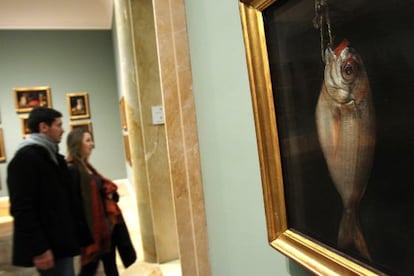Four paintings in Prado Museum alleged to have belonged to Bárcenas
Ex-PP money man attributed part of 38-million-euro fortune to art sales


Four paintings hanging at the Prado Museum were allegedly once owned by Luis Bárcenas, the former treasurer of the ruling Popular Party (PP) who now faces charges of bribery, tax fraud and money laundering in connection with the Gürtel kickbacks-for-contracts case.
Bárcenas claims that part of his hidden fortune in Switzerland — 38 million euros, by his own account — was obtained by buying and selling artwork, besides sound stock market and property investments and consulting work for corporations.
The paintings — three still lifes from the 18th century and one from the 19th — arrived at El Prado in 2006 together with 36 other artworks from the “Naseiro collection,” the result of an agreement between the Spanish government and BBVA bank to pay tax arrears in kind.
To support his claim about the art dealing, Bárcenas showed the judge two handwritten documents detailing transactions in which he made 255,000 pesetas (1,536 euros) from the sale of four still lifes and spent 9,000 euros on the purchase of another painting.
This isn’t the first time his art dealings have turned up in the Gürtel probe
The first document, written by somebody else but signed by Bárcenas, records the sale of four still lifes to Rosendo Naseiro, also a former PP treasurer who stepped down in 1990 after being involved in a case of illegal party financing that was dismissed over technical issues. Naseiro is one of Spain’s premier art collectors.
Bárcenas sold him the paintings in 1984, a year when the still life genre was beginning to gain favor through an exhibition at the Prado. After that their value went up significantly, although the beneficiary was Naseiro. The national museum acquired the paintings in 2005.
Of the four works sold by Bárcenas, the most valuable one is Besugo (Sea Bream), by Bartolomé Montalvo.
This is not the first time that Bárcenas’s art dealings have turned up in the Gürtel investigation. Court papers show two suspicious transactions with 500-euro notes in 2002 and 2006, which the former PP official attributed to the sale and purchase of paintings.
The first transaction was a 330,000-euro loan that Bárcenas took out of a bank in 500-euro notes and returned a month later. He said he used the money to loan it to Rosendo Naseiro so the latter could purchase two still lifes, since he lacked liquidity at the time. In the end, the purchase never took place, and Naseiro returned the money to Bárcenas, who canceled the bank loan.
The second transaction was a 500,000-euro bank deposit made by Bárcenas’ wife, Rosalía Iglesias, at a branch of Caja Madrid savings bank. The tax agency charged Bárcenas with a fiscal crime, but he argued that the money came from the sale of two paintings he purchased in the 1980s and were by now exempt from tax on the added value.
The fact is, the evidence provided by Bárcenas hardly sheds any light on the origin of the fortune he was concealing in Switzerland. The former PP money man also showed Judge Pablo Ruz a certificate from the Uruguayan company Centenary SA, showing that he worked for them between 1995 and 2005 “carrying out commercial and financial advisory tasks, corporate lobbying and promotion of exports to Central American countries \[...\] and receiving commissions for this work.” Bárcenas asked Centenary for this certificate on December 17, 2010, when he had been facing charges over Gürtel for a year-and-a-half. He concealed this job from the Senate when he released information about his assets, as required. He also failed to tell the Swiss bank how he had acquired his fortune when they inquired about the origin of the same.
Tu suscripción se está usando en otro dispositivo
¿Quieres añadir otro usuario a tu suscripción?
Si continúas leyendo en este dispositivo, no se podrá leer en el otro.
FlechaTu suscripción se está usando en otro dispositivo y solo puedes acceder a EL PAÍS desde un dispositivo a la vez.
Si quieres compartir tu cuenta, cambia tu suscripción a la modalidad Premium, así podrás añadir otro usuario. Cada uno accederá con su propia cuenta de email, lo que os permitirá personalizar vuestra experiencia en EL PAÍS.
¿Tienes una suscripción de empresa? Accede aquí para contratar más cuentas.
En el caso de no saber quién está usando tu cuenta, te recomendamos cambiar tu contraseña aquí.
Si decides continuar compartiendo tu cuenta, este mensaje se mostrará en tu dispositivo y en el de la otra persona que está usando tu cuenta de forma indefinida, afectando a tu experiencia de lectura. Puedes consultar aquí los términos y condiciones de la suscripción digital.
Últimas noticias
Maduro pleads not guilty before the federal court in New York: ‘I am still the president of Venezuela’
A new test can detect Alzheimer’s from a finger prick
UN team enters Sudanese city of El Fasher after paramilitary massacre: ‘It’s like a ghost town’
A recipe for resistance: Indigenous peoples politicize their struggles from the kitchen
Most viewed
- Gilles Lipovetsky: ‘If you want to live better and fall in love, take Prozac, don’t look to philosophy’
- Alain Aspect, Nobel laureate in physics: ‘Einstein was so smart that he would have had to recognize quantum entanglement’
- Maduro’s downfall puts China’s relationship with Venezuela to the test
- Why oil has been at the center of Venezuela-US conflicts for decades
- Alvin Hellerstein, a 92-year-old judge appointed by Bill Clinton, to preside over Maduro’s trial in New York








































